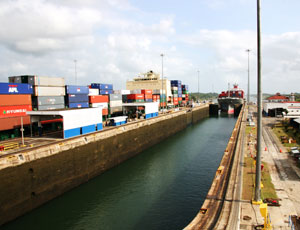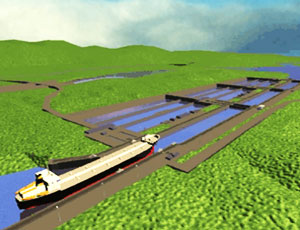Three international consortiums submitted bids on Tuesday to design and build the new sets of locks for the ongoing $5.2-billion expansion of the Panama Canal.


Officials with the Panama Canal Authority – the quasi-governmental organization that oversees the waterway’s administration often known by its Spanish-language acronym, ACP – accepted bids in a ceremony in Panama.
The canal authority has previously projected the lock component of the project to cost $3.35 billion but the actual price tag for the effort was unclear due to the scale of the effort and the confidentiality measures put in place for the evaluation of the three proposals.
The three consortia submitting bids included; Consorcio C.A.N.A.L. led by ACS Servicios, Comunicaciones y Energía, S.L. of Spain; Consortium Bechtel, Taisei, Mitsubishi Corp., led by U.S.-based Bechtel Internacional, Inc. and Grupo Unidos por el Canal, led by Spanish company Sacyr Vallehermoso S.A.
A fourth consortium, Consorcio Atlántico-Pacífico de Panamá led by Bouygues Travaux Publics of France, was approved to participate in the lock building process but did not submit a bid, authority officials said.
“We are very glad we ended up with three of the four consortia submitting bids,” said said ACP Administrator/CEO Alberto Alemán Zubieta. “We respect the business decision of the fourth who decided in the end not to submit a formal proposal to us.”
Aleman would not speculate about the reason Consorcio Atlántico-Pacífico de Panamá chose not to participate but did say all four consortia had concerns with specific aspects of the initial RFP issued in Dec. 2007 that the canal authority worked to address.
The third-lane expansion was overwhelmingly approved by Panamanian voters in 2006 and work on the project formally started in Sept. 2007. Upon completion in 2014, the expansion will more than double the capacity of the historic waterway due to increase traffic as well as permitting the passage of newer post-Panamax vessels to large to use the existing the existing locks.
The ACP is financing the massive infrastructure effort with proceeds from the canal – estimated to hold steady at $2 billion for this year – and $2.3 billion in loans from a group of international lenders approved last year.
The request for proposal for the locks was initially released in December 2007 with a deadline for bid submissions in August of last year. The ACP pushed back the deadline twice, extending the bidding process a full six months.

ALEMÁN
Alemán said the delay was due to requests by the participating consortia for more time to complete their proposals but said the overall timeline of the expansion has not be affected
“Any adjustment they [the consortia] brought to the table required an adjustment in the conditions of the contract,” he said. “When we made those amendments to the RFP they asked for more time in lieu of the changes.”
The initial estimates by the ACP projected the locks themselves would cost approximately $2.73 billion. The gravity-operated, single-lane, three-step locks at the Atlantic and Pacific entrances will boast lock chambers 427 meters long by 55 m wide and 18.3 m deep with sufficient draft for the 366-m-long post-Panamax ships. Instead of the current configuration of miter gates, the new locks will use rolling gates similar to those at the Berendredt canal in Anbres, Belgium.
The new Pacific locks will be situated on the southwest side of the existing Miraflores Locks. The new Atlantic locks will be east of the present Gatun Locks.
The contract also includes the construction of a series of water-saving basins approximately 70 m wide by 5.50 m deep the ACP initially estimated to cost $620 million. A basin will be built for each individual lock, allowing the water to be reused rather than flushed out to sea. Although the sheer size of the new lock chambers will require 65% more water than the existing locks, they will use 7% less water per transit.
Due to the scale of the design build proposals for the locks, the canal authority has divided the selection process into price and technical portion. The price proposals submitted on Tuesday will be set aside while the technical aspects of the submitted bids are evaluated.
Chairman of the ACP Board, Dani Kuzniecky described the evaluation process as “airtight” but stressed the canal authority was also determined to provide as much information as possible about the proceedings.
“The Canal management is firmly committed to an open, fair, rigorous and transparent bid process,” he said on Tuesday.
The three price proposals and the ACP’s owner’s price were placed in sealed envelopes signed by the Notary Public, the ACP Contracting Officer and the Canal’s Inspector General and deposited in the vault of Panama’s National Bank for safekeeping.
The technical aspects of the three proposals will be examined by an Evaluation Committee made up of 15 ACP employees bound by confidentiality and conflict of interest agreements. The committee will be assisted and monitored by business advisory firm Deloitte, chosen last month as the contracting auditor for the locks portion of the project.
The winning bid will be chosen following a public forum where the prices and the evaluation of the technical aspects of the three proposals are presented. While the date has not been set, Alemán said Tuesday the ACP is hoping to have the selection made by summer.
“There are quite a lot of documents put in the hands of the evaluation committee who will be starting work as of today,” he said on Tuesday. “We think, hopefully, by June we should be able to have a decision by that board.”


Post a comment to this article
Report Abusive Comment